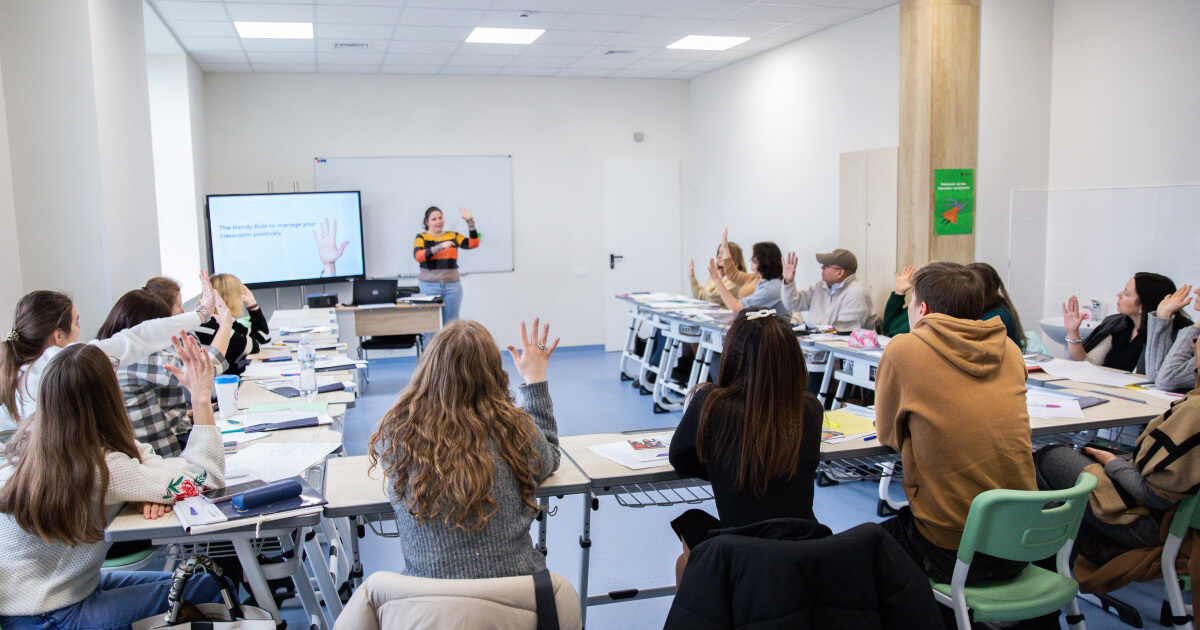Constructive Feedback on Writing: Secrets and Illustrations
- Writing
- Teaching qualifications
- Activities
- Tips & Strategies
- Methodology

20.06.2025
Some classroom activities are complicated. Just imagine the steps that a student has to go through in order to complete something ‘simple’ like a role-playing activity.
They might need to read and understand a prompt, come up with ideas of what to say, then figure out how to say them, then negotiate a situation with another learner (who usually has a different set of information), all to try to reach a reasonable conclusion or achieve a goal they’ve been set.
Because of this, we often ask learners to ‘prepare’ for the activities that they are going to do in the lesson. However, this is a stage which, in my experience both teaching and observing teachers, is often underexplored in many lessons. This begs the question: what can we do to help learners prepare to complete an activity?

Task-Based Learning Lessons
Learn to implement Task-Based Learning effectively in your classroom
When preparing to do a new activity, especially one which is unfamiliar to you, it helps to see an example. It would be quite hard to dance tango if you’d never seen a single dance before, regardless of how good your teacher was!
Additionally, these are very convenient for materials writers to include in coursebooks, so, especially with modern coursebooks, you will likely see models of activities before larger or more complicated tasks that the students need to do.
However, there are a few points that can be helpful when considering what kind of model to provide. One is how many models to provide — for more unfamiliar tasks, you might see success with students being exposed to two, three, or even five models (especially if they are short, i.e. less than a minute each).
You might also consider the quality of the models — do you want all of them to be ‘good’ models, or do you want to compare and contrast features of ‘good’ and ‘bad’ models? Do you want all of them to be the same register, or should some be more formal and some more casual? The answer to this likely depends on your particular lesson aims.
Additionally, models don’t have to come from the coursebook or from ‘native-like’ or ‘proficient’ speakers. Another source of model texts can be the students themselves.
For example, Forman and Ellis discuss a procedure where they asked a higher-level group of students to write stories. At the end of the sequence, after making all the improvements, learners wrote and recorded final versions of their stories, which were then used as models of effective stories for lower level students.
Many exam preparation coursebooks and materials make use of student examples of doing exam tasks rather than ‘native’ or ‘proficient’ speaker examples because students' examples are often more accessible to and easier to understand for learners.
Because we are language teachers, this is likely the first place that many teachers look when they think about what kind of support to provide learners when starting an activity. But how do we know what kind of language to revise or teach in order to help learners?
One way of doing this is to do the task yourself and analyse the language that you used to complete it. Take the following activity from an A1-A2 level YL class I taught recently:
Choose your favourite room in your home. Write a short description of it. In your description, talk about:
I produced the following:
My favourite room in my home is my bedroom. It has a big bed in the middle and a wooden desk near the window. There’s a small bookshelf next to the door. I usually relax there, read books, or do some work at my desk. I like it so much because it’s quiet, comfortable, and it feels like my own little space where I can unwind and be myself.
We can see some areas of language that may be necessary for learners to know to be able to produce something similar:
Or, if we wanted to focus on the task itself, we might identify some useful ‘chunks’ in the model text and choose these to highlight, such as:
This might be a good way to go if the students have already studied or are already able to use the language areas identified earlier.
However, this all refers to teacher-selected language. It’s also possible for learners to choose or decide what language they might need, for example by:
Students may also need ideas that they can talk about. Sometimes, the ideas are indicated on the materials themselves, as we saw in the last section. However, a more open-ended task that gives more freedom to students may also require them to be a bit more creative.
For brainstorming tasks, it’s important that students have a clear idea of the task outcome, so having seen a model or being familiar with the task will be helpful.
It’s also helpful for the students to work in small groups to generate more ideas, although some individual planning time can be beneficial for students who prefer to think before they speak (as opposed to our more extroverted learners who may think better while they speak).
One way that brainstorming can be organised is as a pyramid discussion — ask students to brainstorm on their own, then compare with a partner and choose the best ideas.
After this, combine the pairs to a small group (e.g. 4 students) and ask them to share their best ideas, and repeat until you have the best ideas generated by the whole class.
Developing Reading Skills
Finally, students can benefit from opportunities to rehearse what they are going to do, either with a partner or ‘internally’ through visualisation. In my experience observing teachers, this is the least common type of preparation I observe, yet usually has the potential to be one of the most helpful.
Another way that students can prepare for activities is by using inner speech — in other words, talking to themselves. While this may sound unusual, this is something we often do in the ‘real world’ — practice a conversation in our heads before having it with another person, as it provides a safe space for rehearsal and experimentation.
We also know that during task performance, there can also be a connection, and students who have an internal monologue which is overly self-critical tend to perform worse in tasks.
One classroom activity making use of this is shadowing, where learners first listen to a model task / dialogue and read it aloud internally (i.e. with their inner voice), then with a low voice, then at normal volume.
Underhill, A. in ‘Sound Foundations: Learning and Teaching Pronunciation’ suggests another activity for helping learners with a particular feature of pronunciation before a task starts (e.g. polite intonation), is to first play an audio track / provide a model containing the target feature, and then ask Ss to ‘play it back’ in their heads over and over, in their own voice. Then, ask learners to repeat silently, and then quietly, and then out loud.
Visualisation can also be an important component, especially for tasks which require students to take certain speech acts which they might be uncomfortable taking, such as interruption.
Imagine that a group of students is preparing for a task where they need to work in large groups (6-8 students) and participate in a meeting, like the kind you have at work. A useful visualisation activity could be the following:
Before starting the task, ask the students to close their eyes and imagine themselves participating in the meeting. Ask them to imagine one of their classmates making a point where they really want to participate, either in agreement or disagreement.
Then, they imagine interrupting successfully — they interject, make their point, and everyone responds positively to it. Ask them to imagine how they feel while doing it, and how they feel after.
Then, ask them to imagine again. This time, they interrupt, and the person tries to talk over them. Ask them to imagine holding the floor and insisting on being heard (politely, of course!). They imagine what they will say and how it feels to do so. Then, once learners are prepared, start the activity.
While this might sound a bit ‘new-agey’ or ‘weird’, visualisation has a long history of use with participants ranging from patients undergoing therapy to professional athletes and cage fighters, and often shows great results.
Moreover, learners may encounter problems when completing tasks that have nothing to do with their level of proficiency in L2 — such as being hesitant or shy to interrupt — which visualisation may help address, and there is some research to show that visualisation can have a positive impact on learners’ willingness to engage with classroom activities.
Visualisation also goes hand in hand with goal setting. That is, making sure that students have a clear internal mission for the activity.
Some of these may be included into tasks themselves (i.e. in a role-play for returning a product, the goal could be ‘get the customer service agent to agree to a refund’) as an outcome-based goal, or they could be more language-based goals, especially at higher levels (i.e. in the same role-play, ‘I’m going to use emphatic pronunciation to show that I mean business’ or ‘I’m going to use more third conditional structures to show that it was the company’s fault, not mine!’).
Having clear goals gives students something to focus on, and helps to make their language practice more intentional, often resulting in better learning.
Sometimes, the most important element of preparing for a task is simply having a quiet space to prepare yourself. Preparation is at its core a thinking activity, and even the performance stage of a task is as much a thinking activity as it is a social activity.
Bao, D. in ‘Silence in English Language Pedagogy: From Research to Practice’ puts forward a series of suggestions which indicate when silence may be particularly useful, including (but not limited to) when the materials are intrinsically engaging or inspiring, when silence gives the leaners space for creative engagement, and when the period of silence is both clearly connected to language output (such as through clear preparation activities) and results in higher-quality language production.
One example of ‘productive’ silence is to let learners have ‘paper conversations’ before starting a task involving discussion or dialogue. Here, learners perform the same speaking task that they would normally complete, except they do so by passing a sheet of paper back and forth (or, in online lessons, writing in the chat) and writing their ‘conversation’ there.
This helps to remove the time-based pressures of spoken communication and gives the learners more time to think, see the language that they’re using, and possibly even correct mistakes or take conscious steps to incorporate new language, especially if prompted to do so.
Mental Health and the New Generation: Supporting Students in a Fast-Paced World
The preparation stage of any activity is often a critical step where teachers can positively influence the outcome of the activity and help students greatly, and, because of this, it’s important to think carefully about it while planning lessons.
This article is not meant to be an exhaustive list of the possibilities which teachers can use while preparing learners, but rather as a starting point from which to build off of and develop further. However, there are a few final points to bear in mind regarding task preparation:
Chris Reese
Author
Senior Teacher & Teacher Trainer | General English, Young Learners, International Speaking Examiner
Comments
Leave your comment